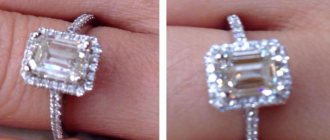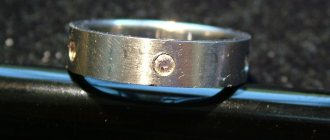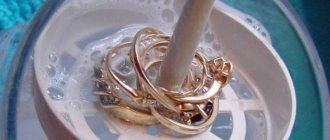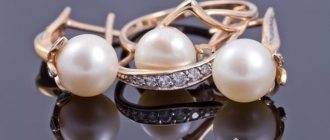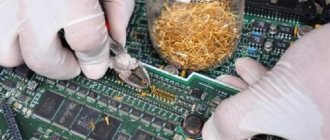Characteristics and properties of metal
Silver is an inert metal and in its pure form does not oxidize in air. It is quite refractory - to transform it into a liquid state, you will need to heat the substance to a temperature of 962 degrees Celsius, and it will be possible to bring it to a boil at 2210 ° C. This is a heavy substance - a cube with centimeter sides will weigh 10.5 grams.
The element has high ductility, as well as the highest coefficient of thermal conductivity and electrical conductivity among metals, due to which it is widely used in various industries. For example, in the manufacture of batteries with extended service life and all kinds of electronic devices.
Silver lends itself well to forging, which makes it possible to produce exquisite jewelry from it. Widely used in medicine as a raw material for the production of instruments and medicines.
Properties of silver
Silver has a high density, which makes it heavy and allows it to be made into thin foil and wire.
Another undeniable advantage is its exceptional thermal and electrical conductivity - the best among all metals - which has made it almost indispensable in the chemical industry and in the manufacture of high-tech devices.
- Applications and properties.
- Melting temperature.
- Melting at home.
Since ancient times, people have known the disinfecting properties of this metal, which also contributed to its wide distribution. Even in Ancient Egypt, silver plates were applied to wounds, and in Persia BC, water for the fighting army was stored in silver vessels.
Areas of use of silver
Nowadays, this property is also successfully used by humanity - all kinds of water and air filters, parts in refrigerators , washing machines, and medical equipment are made using silver ions.
Surprisingly, silver has also found its place in the food industry - it is registered as a food additive E174 and is part of many biologically active substances, although the usefulness of their use is debatable.
Colloidal silver is often credited with its beneficial effects in the prevention of colds and flu, as well as the ability to heal diabetes, cancer, chronic fatigue syndrome, HIV/AIDS, tuberculosis, and other truly serious diseases.
However, such miracles are more of a marketer's dream, since there are no medical studies confirming that colloidal silver is effective in treating any of these diseases.
Nevertheless, the areas of application of this metal are constantly expanding; alloys and chemical compounds can be found both in almost any apartment and in space as part of parts for satellites and spacecraft.
Among the “minuses” we can highlight the property of silver products to tarnish and darken over time under the influence of moist air. A slightly soluble coating forms on the surface, but this is also fixable - cleaning allows you to restore its former shine.
As for the beneficial effects on human health, you need to know in moderation in everything and remember that this is a heavy metal, the excess content of which in drinking water is dangerous to health.
It is mainly used not in its pure form, because silver without impurities is a rather soft, plastic material. The most common alloys found in silver are cadmium, nickel, zinc and copper. These components make working with metal easier and make the final products stronger.
There are many reasons why there is a need to melt silver. This may be a desire to make the metal cleaner, and therefore more expensive, by freeing it from impurities.
Or maybe you decided to melt down a ring or cutlery inherited from an unloved aunt and create a new modern piece of jewelry of your own design. In any case, the first thing you need to do is find out at what temperature silver melts.
How raw materials are processed
The raw materials for obtaining the substance can be scrap of precious metals, industrial waste, or mined ore. To extract the precious metal, the following processing steps are applied step by step:
- Grinding. Recycled raw materials are crushed to obtain a fine mass.
- Firing allows you to remove flammable debris from the composition.
- Centrifugation is the separation of molten silver from other metals except lead.
- Remelting. During the cooling process in the crucible, liquid lead is separated from the noble metal, which solidifies faster.
- Electrolytic processing. The precious metal, dissolved in nitric acid, is exposed to electricity, causing the anode to attract impurities and silver to crystallize around the cathode.
- Chemical treatment allows you to obtain a substance of 1000 samples. The noble metal is dissolved using sulfuric and hydrochloric acids and ferric chloride, precipitating it with zinc. Silver is released from the solution in the form of sand, which is washed and remelted.
At what temperature does it melt?
Depending on the sample and alloy composition, the precious metal changes its melting point, which decreases in proportion to the mass fraction of the precious element in the alloy.
| 800 sample | 780–820 °C |
| 875 sample | 780–870 °C |
| 900 sample | 780–890 °C |
| 925 sample | 810–910 °C |
| 960 sample | 900–940 °C |
| 999 sample | 960 °C |
What metals are used in silver alloys, how do they change the melting point
In the jewelry industry, copper is used as a ligature component. The temperature of the alloy decreases in proportion to the sample.
Platinum is used as an alloy in the creation of high-precision instruments. The melting point of such a metal ranges from 1000 °C.
An alloy of silver and palladium is widely used in dentistry. At a sample of 820 and above, the melting point of such an alloy is 1100 °C, however, a further decrease in the sample also lowers the melting point.
In electronics, alloys of technical silver with cadmium and tin are used as solders. Their melting point can range from 400 to 850 °C.
Physical characteristics of silver
Having many advantages, silver also has its disadvantages. In particular, rapid oxidation when interacting with hydrogen sulfide, which is in the air. With such a reaction, silver becomes covered with a dark coating.
This is the primary cause of blackening of cutlery. When purchasing material for further melting, it is important to know what characteristics it has:
- Silver melts at a temperature of 961.9 degrees. The boiling process begins at a temperature of 2210 degrees.
- The high reflectivity of silver and its malleability when forged make the metal an excellent material for making jewelry and other products.
- Silver is used in various technical industries due to its thermal conductivity. Clamps and microcircuits are made from it. However, noble metal is often replaced with other materials due to its high cost.
- Silver has a density 10 times greater than the density of water.
If you decide to melt this metal yourself, it is important to know that the melting point of silver is directly related to its purity.
It is this indicator that makes it clear how much pure metal is contained in the alloy, and is determined as a percentage. Interesting! For example, a 925 alloy contains 92.5% silver, the remaining 7.5% is various impurities.
For such a sample, the melting point will be approximately 889 degrees. If the alloy contains less than 90% silver, then the metal will melt at a temperature not exceeding 770 degrees. The most common silver samples used in the jewelry industry are: 750, 800, 875, 916, 925, 960. The 999 sample is extremely rarely used by craftsmen, since this material is too soft.
You may be interested in: 925 sterling silver: characteristics and features
Is it possible to melt silver at home?
Heating silver to a liquid state and melting it into one ingot at home, using improvised means, is not at all difficult. The procedure itself may take no more than 10 minutes.
Necessary equipment and materials
To conduct this experiment you will need:
- precious scrap;
- burner;
- crucible (fireproof container);
- mold (mold);
- pharmaceutical borax;
- forceps;
- metal container with water.
Batch preparation
To reduce the remelting time of our metal, it must be crushed. Borax is placed in the crucible at the rate of 1/10 of the weight of the metal and heated using a gasoline or gas burner.
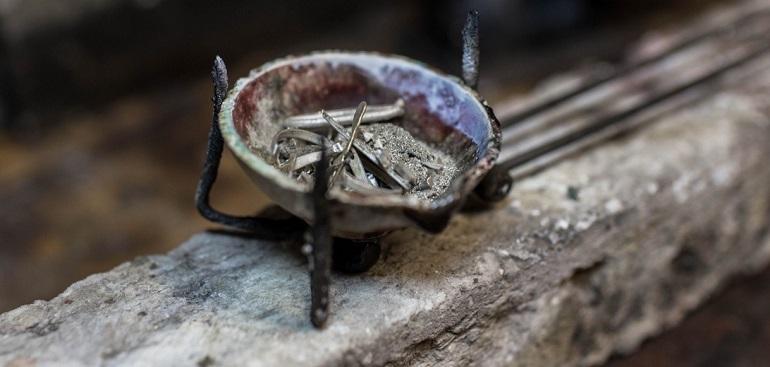
Melting process
When the borax turns green, you can pour out the metal shavings. To make the process move faster, it is better to acquire a powerful melting device.
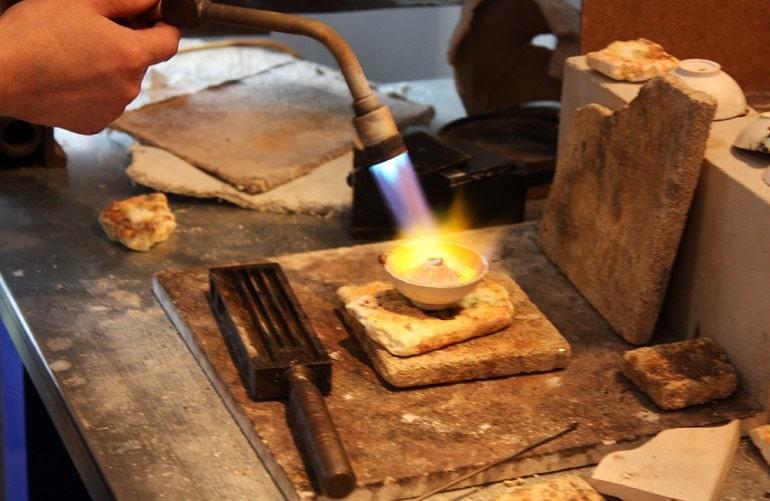
Before pouring liquid silver into the mold, it must be warmed up well, otherwise all efforts may go down the drain. In the absence of a second burner, you can do this on a gas stove. You also need to add borax to the mold.
Receiving castings
Carefully pour the metal into the mold, wait a few minutes, then use tongs to remove the resulting ingot and place it in a container of water to cool.

Physical properties
Refined metal has many advantages that distinguish it from more expensive materials. However, the main disadvantage is the rapid oxidation of silver and its entry into a chemical reaction with hydrogen sulfide. The substance is found in excess in the air. This is why silver jewelry quickly darkens.
For this reason, some prefer to choose products from other metals. Silver has the following physical properties:
- It has a high density, allowing the material to be used for the production of fine weaving, foil, and wire.
- The reflection coefficient is 95%. The high rate is ensured due to the light shade and shine of well-processed metal.
- High electrical and thermal conductivity allows the use of silver in the manufacture of industrial objects, microcircuits and contacts. The cost of a refined ingot is high, so manufacturers prefer to use a low grade.
- The melting point of silver at home and in production is almost the same if you take bars of the same size and standard.
- The density of silver is 10.5 g per cubic centimeter. The indicator exceeds the density of water by almost 10 times.
- The melting point of technical silver is slightly lower than the figure for a high-quality ingot. This is due to the amount of pure metal in the ingot or piece. A higher percentage increases the score significantly.
It is worth knowing that remelting a 925 sample item will be easier than carrying out the procedure with a 999 sample ingot or jewelry. The latter is used extremely rarely, since jewelry and household items made from such silver are quite soft and do not hold their shape well.
How to remove impurities at home
This procedure is also feasible, but I would like to draw your attention to the fact that working with concentrated acids requires extreme caution and should be carried out in a ventilated room.
The size intended for cleaning is placed in a glass container, filled with concentrated nitric acid and heated until the silver is completely dissolved. After this, regular table salt is added to the solution. The resulting silver chloride precipitates. The resulting substance is washed with water and filtered.
The next stage is metallization of the substance. Silver chloride is poured into hydrochloric acid and precipitated using fine zinc filings and heat. The resulting dark gray sand is ready for melting.
How to recover and reuse silver
Taking into account all the characteristics of the metal and taking into account where the silver is extracted from, you can decide on the process required for this. The melting point of technical silver is quite high, about 900 °C, and this must be understood when choosing a method for heating the material and container. It is optimal to use a gas burner and a steel container or fireproof earthenware for melting.
It is quite possible to melt silver at home, but it is important to follow all safety rules and take into account those chemical reactions that can cause impurities in the metal. Therefore, it is better to do this not in the apartment. A gas burner will provide an even flow of fire (not affected by wind) and does not require power from the mains. This melting method is suitable for single use.
If there is a need for constant melting, then it is better to build a furnace.
It can be either electric (you will need an asbestos plate, mica, graphite, wires with good insulation and a direct current source with high power), or with gas heating. The fact that the metal has melted can be judged by the appearance of the composition. It will become shiny, and a so-called silver flash will appear at the top. The presence of a film on top indicates that the process is not completed. Liquid silver can either be immediately poured into ready-made molds, or it can be purified from impurities. It is especially necessary if material from different devices and jewelry were taken during melting.
Cleaning is carried out in a ventilated area, or even better, outside, since during the reaction of silver with nitric acid, a lot of heat and a specific odor are released. After the first reaction has taken place, a saline solution is added to the container - this leads to the sedimentation of silver chloride at the bottom. Next, when adding ordinary water, the metal is completely cleaned (it is necessary to ensure that the liquid becomes transparent). The resulting sludge will have better characteristics and, accordingly, the likelihood of its reuse will increase.
